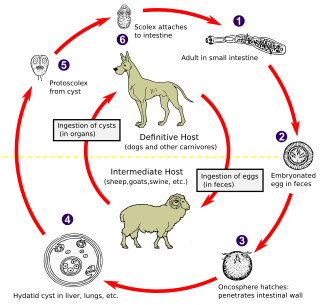
Echinococcosis is a parasitic disease caused by tapeworms of the Echinococcus type. The two main types of the disease are cystic echinococcosis and alveolar echinococcosis. Less common forms include polycystic echinococcosis and unicystic echinococcosis.
The Centrophoridae are a family of squaliform sharks. The family contains just two genera and about 15 species. They are sometimes called gulper sharks, but this is also the name of a specific species in the family, Centrophorus granulosus. These are generally deepwater fish. While some, such as the gulper shark C. granulosus, are found worldwide and fished commercially, others are uncommon and little-known. Their usual prey is other fish; some are known to feed on squid, octopus, and shrimp. Some species live on the bottom (benthic), while others are pelagic. They are ovoviviparous, with the female retaining the egg-cases in her body until they hatch.

Echinococcus granulosus, also called the hydatid worm or dog tapeworm, is a cyclophyllid cestode that dwells in the small intestine of canids as an adult, but which has important intermediate hosts such as livestock and humans, where it causes cystic echinococcosis, also known as hydatid disease. The adult tapeworm ranges in length from 3 mm to 6 mm and has three proglottids ("segments") when intact—an immature proglottid, mature proglottid and a gravid proglottid. The average number of eggs per gravid proglottid is 823. Like all cyclophyllideans, E. granulosus has four suckers on its scolex ("head"), and E. granulosus also has a rostellum with hooks. Several strains of E. granulosus have been identified, and all but two are noted to be infective in humans.

The gulper shark is a long and slender dogfish usually about three feet in length generally found in deep, murky waters all around the world. It is a light grayish brown, paler ventrally, with a long snout and large greenish eyes. This deep water shark has two dorsal fins with long, grooved spines and the second dorsal fin smaller than the first. Its upper teeth are blade-like and lower have finely serrated edges. This tertiary consumer feeds on mainly fish such as bony fish, but also cephalopods such as squid and other invertebrates like crustaceans. The gulper shark is currently an endangered species mainly because of exploitation by humans and their abnormally long gestation period and low fecundity, preventing their population from recovering. Because of the depth of their habitat, they are considered little to no threat to humans.

The dwarf gulper shark is a dogfish of the family Centrophoridae found in the Indo-West Pacific oceans, from the Gulf of Aden, Japan, Taiwan, and northern Papua New Guinea, living and feeding at dephts exciding 656 ft (m), marine, deep-water dogfish most commonly found between 328 ft and 3937 ft

The southern lanternshark is a shark of the family Etmopteridae found in the southeast Pacific between latitudes 29°S and 59°S, at depths of between 220 and 1,460 m. This species has been found off Northland, off the Chatham Islands, on the Campbell Plateau, all in New Zealand waters. Its length is up to 60 cm. Reproduction is ovoviviparous, with 10 to 13 pups in a litter, length at birth about 18 cm. They exhibit bioluminescence.
Amolops granulosus is a species of frog in the family Ranidae that is endemic to China.

The granulated catfish is a species of thorny catfish found in the Paraná and Amazon basin as well as the coastal drainages of Suriname and Guyana. This species is commercially caught for human consumption as well as being displayed in public aquaria.

Hammatoderus is a genus of longhorn beetles of the subfamily Lamiinae, containing the following species:
Hammatoderus albatus is a species of beetle in the family Cerambycidae. It was first described by Henry Walter Bates in 1880. It is known from Panama and Costa Rica.

Hammatoderus lunaris is a species of beetle in the family Cerambycidae. It was described by Henry Walter Bates in 1880. It is known from Mexico.

Hammatoderus maculosus is a species of beetle in the family Cerambycidae. It was described by Henry Walter Bates in 1880. It is known from Guatemala, El Salvador, Mexico, Honduras, Belize, and Nicaragua.
Hammatoderus ornator is a species of beetle in the family Cerambycidae. It was described by Henry Walter Bates in 1885. It is known to exist in Mexico.
Hammatoderus elatus is a species of beetle in the family Cerambycidae. It was described by Henry Walter Bates in 1872. It is known from Mexico, Costa Rica, Ecuador, Colombia, Honduras, Panama, and Nicaragua.

Hammatoderus rubefactus is a species of beetle in the family Cerambycidae. It was described by Henry Walter Bates in 1872. It is known from Nicaragua, Mexico, Costa Rica, and Panama.
Hammatoderus lacordairei is a species of beetle in the family Cerambycidae. It was described by James Thomson in 1860. It is known from Panama and Mexico.
Hammatoderus emanon is a species of beetle in the family Cerambycidae. It is known from Nicaragua, Costa Rica, and Panama. It was originally described by Dillon and Dillon in 1941 as Plagiohammus emanon, but later combined into the genus Hammatoderus, thus making the current binomial name Hammatoderus emanon.
Hammatoderus colombiensis is a species of beetle in the family Cerambycidae. It was described by Constantino, Benavides and Esteban in 2014. It is known from Colombia.
Hammatoderus decorus is a species of beetle in the family Cerambycidae. It was described by Chemsak and Linsley in 1986. It is known from Mexico.

Hammatoderus thoracicus is a species of beetle in the family Cerambycidae. It was described by White in 1858. It is known from Mexico, Costa Rica, Guatemala, Panama, Honduras, Colombia, Nicaragua, Peru, El Salvador, and Venezuela.










